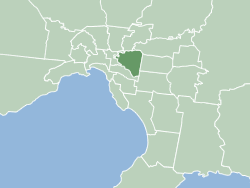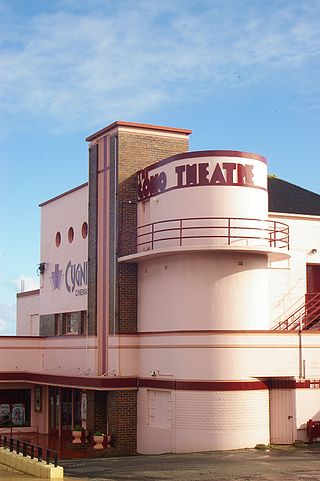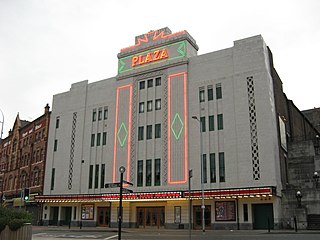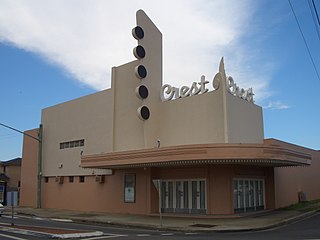
The City of Boroondara is a local government area in Victoria, Australia. It is located in the eastern suburbs of Melbourne. It was formed in June 1994 from the amalgamation of the Cities of Kew, Camberwell and Hawthorn.

The Odeon Luxe Leicester Square is a prominent cinema building in the West End of London. Built in the Art Deco style and completed in 1937, the building has been continually altered in response to developments in cinema technology, and was the first Dolby Cinema in the United Kingdom.

Balwyn is a suburb of Melbourne, Victoria, Australia, 10 km east of Melbourne's Central Business District, located within the City of Boroondara local government area. Balwyn recorded a population of 13,495 at the 2021 census.

Streamline Moderne is an international style of Art Deco architecture and design that emerged in the 1930s. Inspired by aerodynamic design, it emphasized curving forms, long horizontal lines, and sometimes nautical elements. In industrial design, it was used in railroad locomotives, telephones, toasters, buses, appliances, and other devices to give the impression of sleekness and modernity.

The Capitol is a theatre on Swanston Street in the central business district (CBD) of Melbourne, Victoria, Australia. Opened in 1924 as part of the Capitol House building, the art deco theatre was designed by American husband and wife architects Walter Burley Griffin and Marion Mahony Griffin. It is the oldest of Melbourne's large picture palaces and is known for its extravagant decor and abstract motifs, including an intricate geometric ceiling containing thousands of coloured lamps designed to evoke the walls of a crystalline cave.

Village Cinemas is an Australian-based multinational film exhibition brand that mainly shows blockbusters, mainstream, children and family films and some arthouse, foreign language and documentary films.

The Hexagon is a multi-purpose theatre and arts venue in Reading, Berkshire, England. Built in 1977 in the shape of an elongated hexagon, the theatre is operated by Reading Borough Council under the name "Reading Arts and Venues" along with South Street Arts Centre and Reading's concert hall.

Regent Theatre was a heritage-listed cinema at 167 Queen Street, Brisbane, Australia. It was designed by Richard Gailey, Charles N Hollinshed and Aaron Bolot and built from 1928 to 1929 by J & E L Rees and A J Dickenson. It was one of the original Hoyts' Picture Palaces from the 1920s. It is also known as Regent Building. The auditorium interior was largely lost when it was converted into a 4 screen complex in 1979–1980, but the building, including the surviving entrance and main foyer, was added to the Queensland Heritage Register on 21 October 1992.

Camberwell Junction is a major intersection in Camberwell, a suburb of Melbourne, Australia. Burke, Riversdale and Camberwell Roads meet here on six different legs. Trams that pass through the junction run on the routes 70, 72 and 75.

The Rivoli Ballroom is the only intact 1950s ballroom remaining in London, England. It is famed for its original decor and interior fittings, including red velvet, flock wallpaper, chandeliers, glitter balls and oversized Chinese lanterns. The venue is often used as a film location and plays host to many dance and musical events.

Cygnet Cinema is located at 16 Preston Street, Como, Western Australia. It was the first purpose built sound cinema in the suburbs immediately south of the city in the inter-war period. The Cygnet Cinema opened in 1938 and was built by local identity and film entrepreneur James Stiles. It is an excellent example of the art deco style of architect William Leighton and is included on the State's Heritage Register.

The Plaza is a Grade II* listed art deco single-screen cinema and theatre in Stockport, Greater Manchester, England. It opened in 1932, its construction having involved the excavation of the sandstone cliff behind it. After an initial closure in 1966 and a subsequent period in use as a bingo hall by Rank Leiure, it has now been restored as a cinema and theatre, showing films and staging live shows.

Vogue Theatre is an Art Deco / Art Moderne styled building originally built as a movie house, and currently used as an event venue for the performing arts. Situated on Vancouver’s “Theatre Row", the building was designated as a National Historic Site of Canada in 1993.

The former Plaza Theatre is located at 650–658 Hay Street, Perth, Western Australia. It was the first purpose-designed Art Deco cinema in Perth. The Plaza Theatre opened in 1937 and was built for Hoyts Theatres Ltd.

Strand Theatre is a heritage-listed cinema at 159–167 Margaret Street, Toowoomba City, Toowoomba, Toowoomba Region, Queensland, Australia. It was designed by George Henry Male Addison and built from 1915 to 1933 by Luke Halley. It was added to the Queensland Heritage Register on 21 October 1992.

The Scone Civic Theatre is a heritage-listed cinema at 144 Kelly Street, Scone, Upper Hunter Shire, New South Wales, Australia. It was designed by Guy Crick and Bruce Furse and built from 1937 to 1938 by Mr A. F. Little. The property is privately owned. It was added to the New South Wales State Heritage Register on 21 February 2003.

Crest Theatre is a heritage-listed former cinema and ballroom and now community centre at 157 Blaxcell Street, Granville, City of Parramatta, New South Wales, Australia. It was designed by Cowper and Murphy and Associates and built in 1948 by A. W. Edwards Pty Ltd. It is also known as Hoyts Crest Theatre. Following its purchase by the Australian Blouza Association, it has been referred to as Blouza Hall. It was added to the New South Wales State Heritage Register on 1 August 2003.
In 1925, Hugh Vivian Taylor formed a partnership with fellow Melbourne architect, Garnet Argyle Soilleux, a collaboration that lasted for many years and had a significant impact on Australian architecture. For many years the firm, H. Vivian Taylor & Soilleux operated out of an office on Collins Street in Melbourne. In 1933, prominent modernist architect, Best Overend, joined the firm as a partner, and for several years, the practice operated as Taylor, Soilleux & Overend. This partnership continued until 1937, when Overend departed, and the firm it returned to the previous name.


















